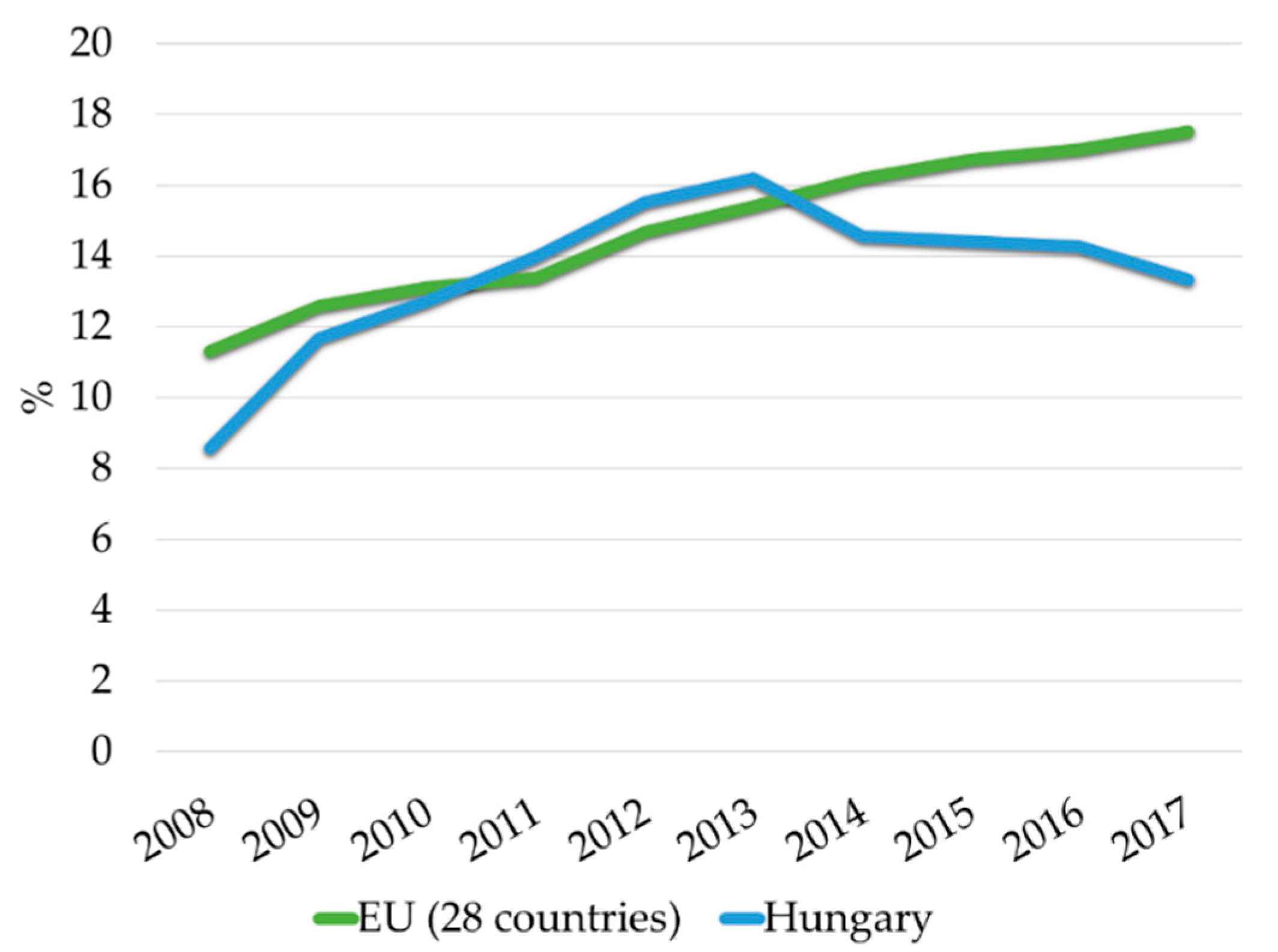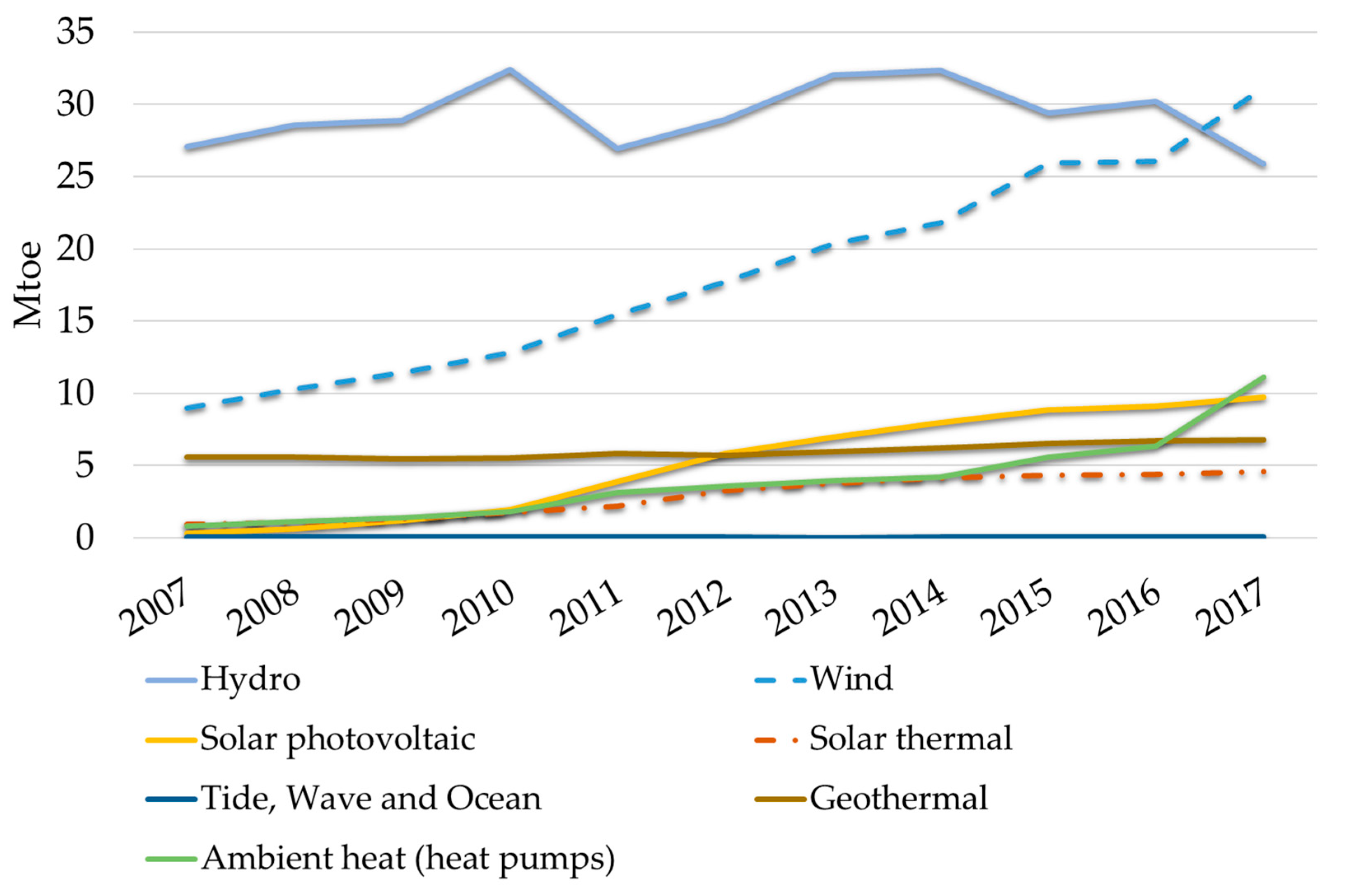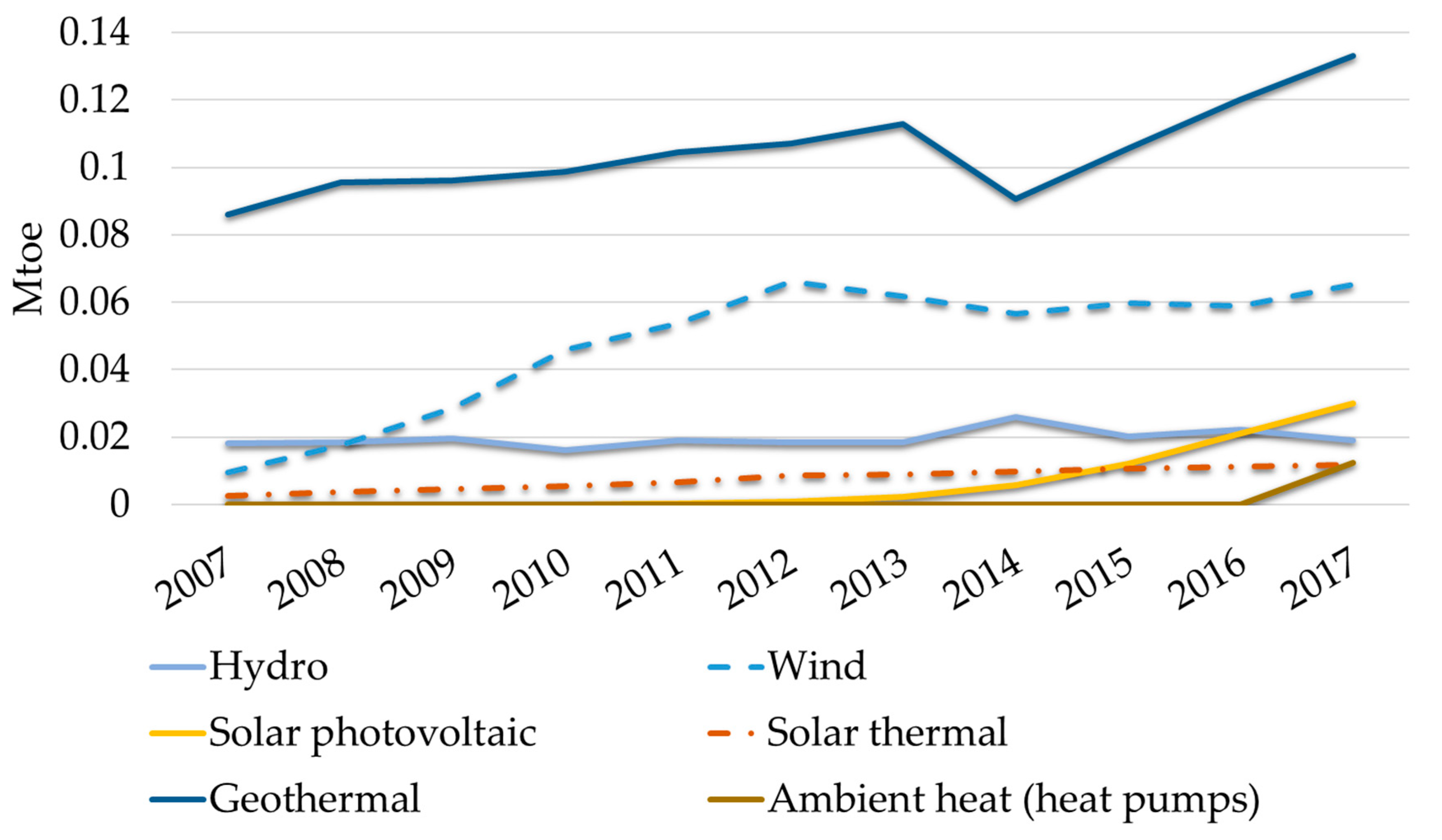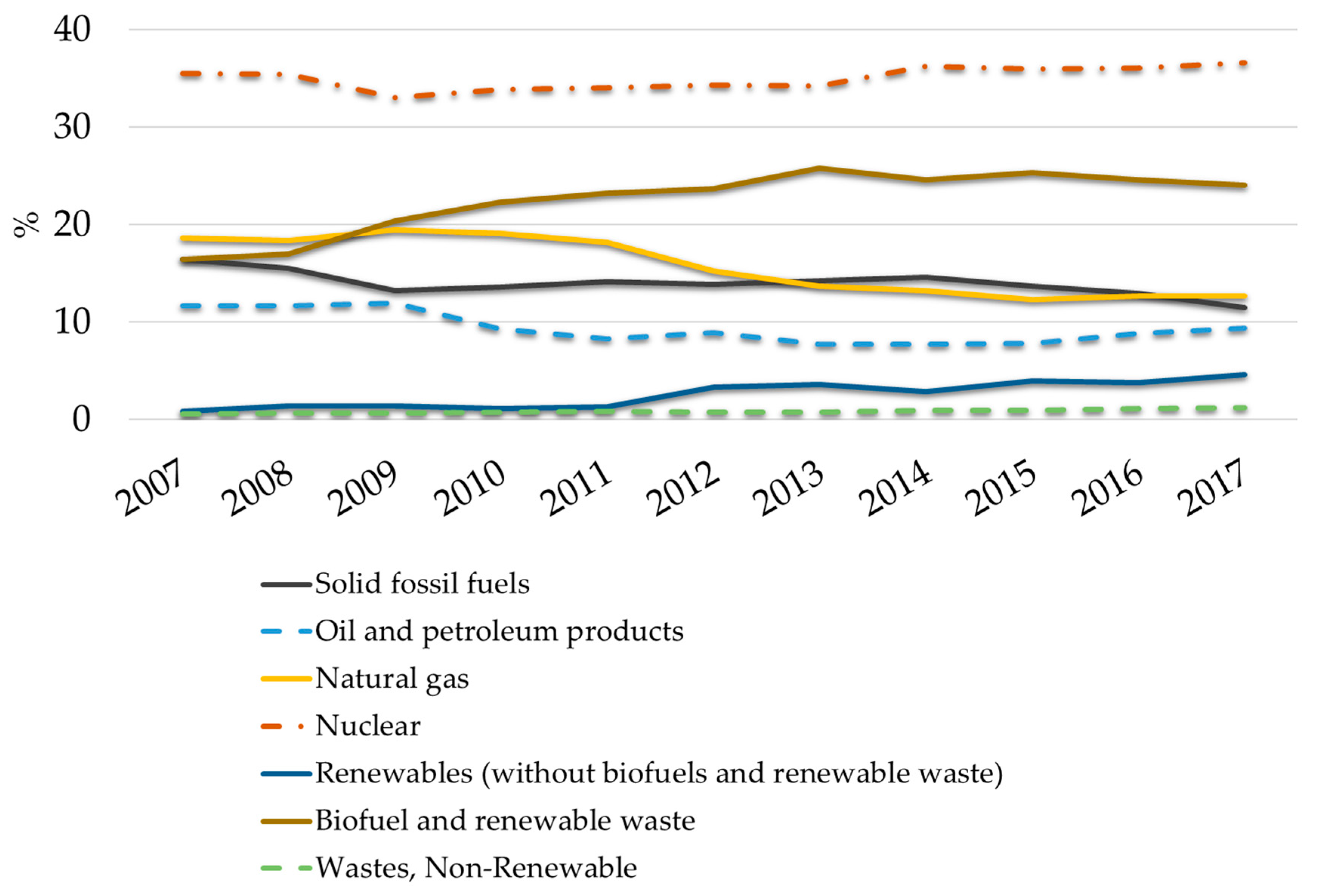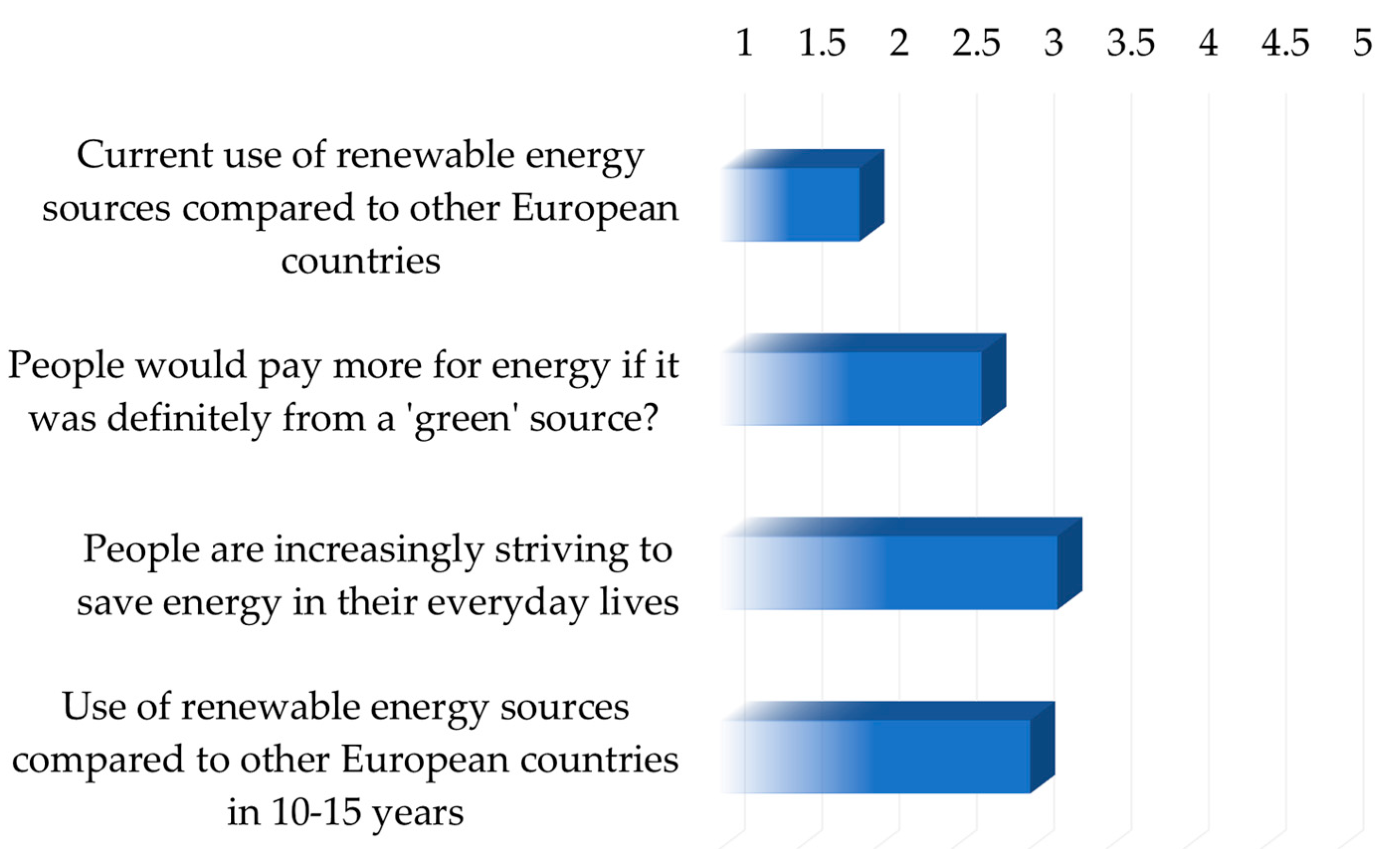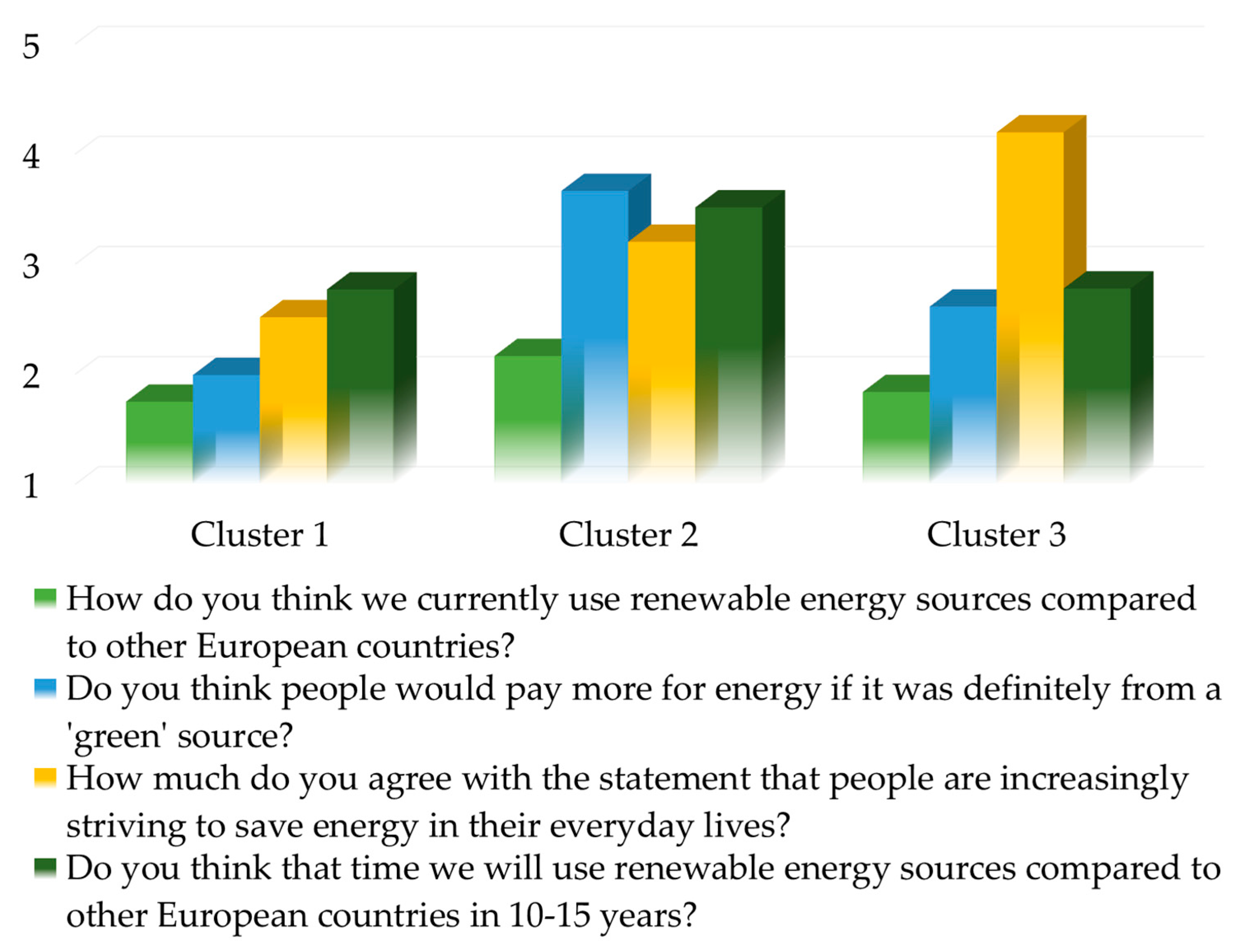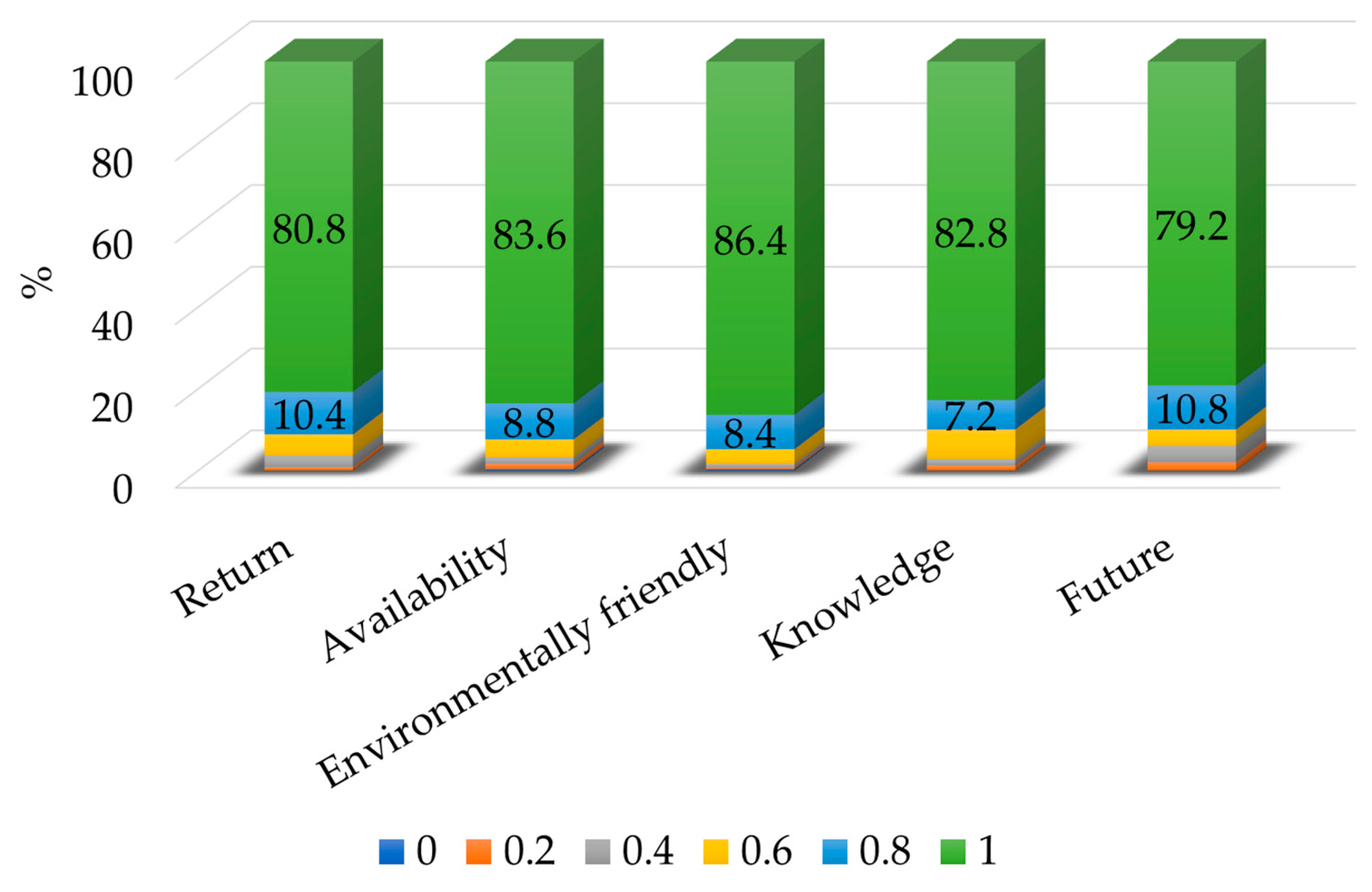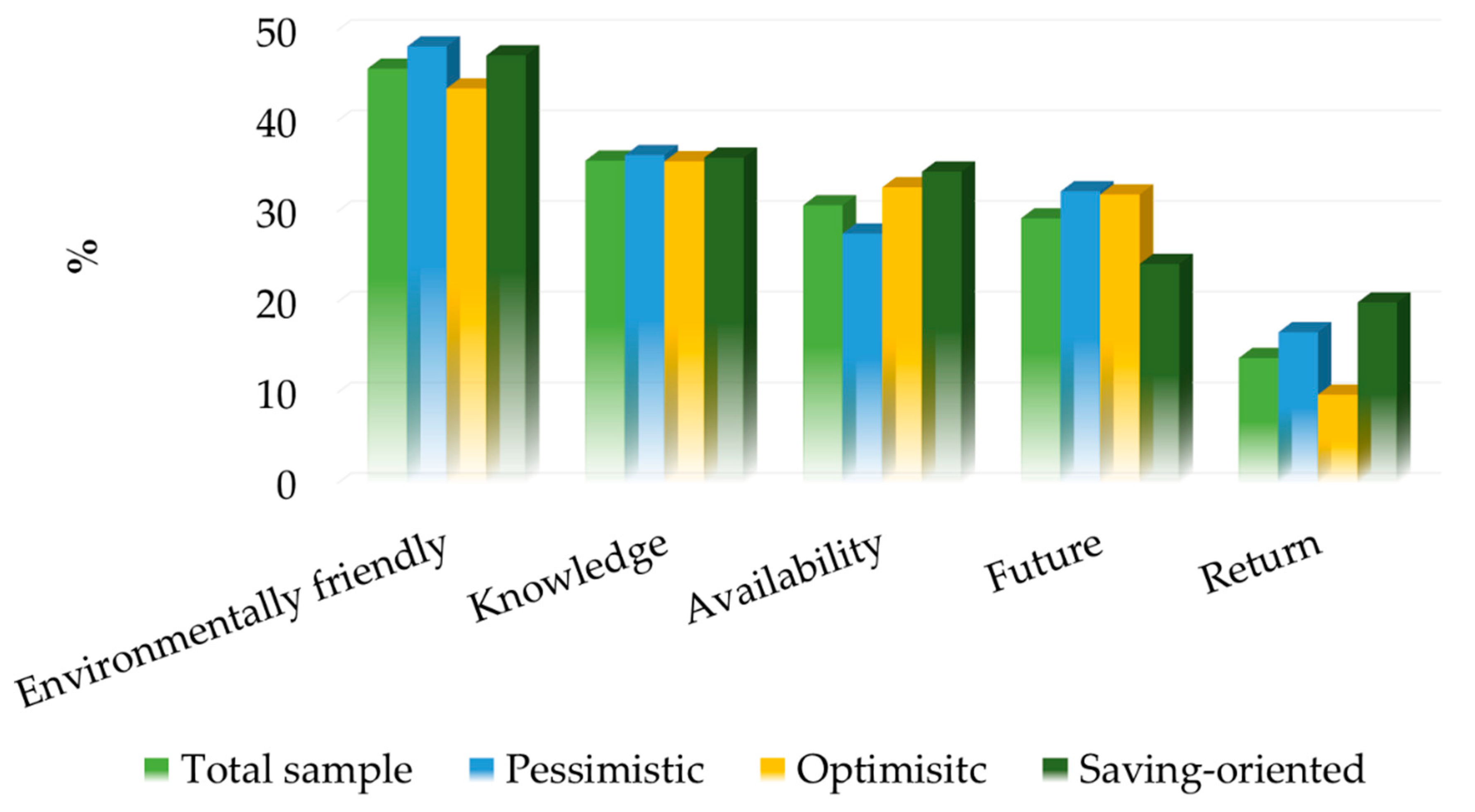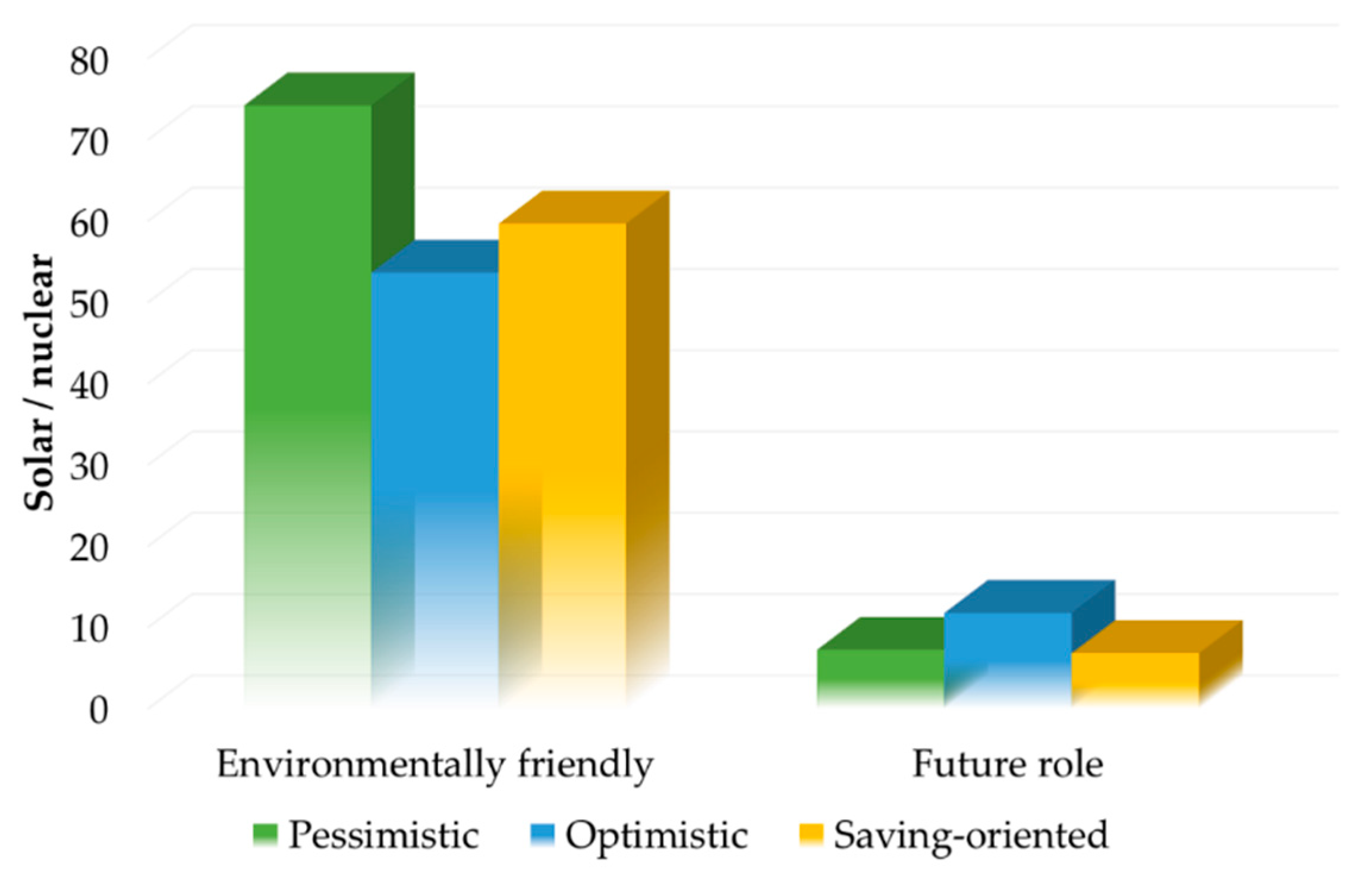1. Introduction
A joint result of population growth and technical development is that the energy dependence of the economy and society is increasing [
1]. Energy must be considered an essential ingredient of socio–economic development and economic growth [
2]. However, it is fundamentally agreed that the depletion of fossil energy sources is inevitably approaching. Finding alternative energy sources is an essential but multifaceted challenge. Issues with energy generation are highly connected with climate change and environmental protection.
However, sustainable development could help solve these issues. The long-term strategy of the European Union regarding climate-neutrality [
3,
4] covers many issues that can be combatted using sustainable energy. According to Wolsink [
5], policymakers and researchers present renewables as a solution to environmental problems, particularly global issues linked to fossil fuels and nuclear power. Both the European Union and the Hungarian government emphasize the importance of renewables [
3,
6]. These public efforts are encouraging, but statistics show that progress is slow.
Based on the EUROSTAT database [
7], the share of energy produced by renewable sources increased from 11.3% to 17.5% in the European Union between 2008 and 2017; however, this remains below the target value of 20% for 2020 [
8]. The share of renewables in Hungary is lower than the EU average, and the gap widened from 2013 to 2017 (
Figure 1).
According to the energy statistics for the EU [
9], the gross inland consumption of EU-28 countries was 674.92 Mtoe in 2017. The production was 45.37% of this (759.84 Mtoe), from which 29.82% was from renewables and biofuels and 27.73% was from nuclear sources. Hungarian energy consumption was 10.77 Mtoe (3.96% of the EU-28 consumption), and its production was 11.15 Mtoe (1.51% of the EU-28 production). Renewables and biofuels made up 28.63% of that production, and nuclear power comprised 36.64%. Of the renewables utilized for the gross inland consumption, biofuels and renewable waste were the most relevant sources, comprising 61.71%–68.75% of EU-28 consumption between 2007 and 2017, and were even more critical in Hungary (90.80%–94.12% during the same period). The pattern of the gross inland consumption of renewables (without biofuels and renewable waste) is presented in
Figure 2 and
Figure 3.
The National Energy Strategy 2030 of Hungary [
6], published in 2012, offers a scenario entitled ‘Nuclear-Coal-Green’. This strategy aims at the long-term maintenance of nuclear energy in the energy mix, continuing to increase renewables depending on economic capacities and technological developments. The structure of energy production by sources shows that restructuring already began a few years earlier (
Figure 4.).
However, the National Energy Strategy 2030 of Hungary includes maintaining coal-based energy production as a security reserve for economic or technical crises with a commitment to carbon dioxide capture and the full application of clean coal technologies. The wording reflects the complex socio–economical nature of the problem, including the need for education and professional training for the energy sector. Understanding these energy strategies and their technological background requires a broader approach.
Renewable and nuclear energy are two plausible alternatives to fossil fuel-based energy production [
10]. Busu [
11] formulated the idea to reduce CO
2 emissions, and one of the solutions involves increasing the use of renewables. Both methods have several benefits and barriers, including the availability or social acceptance of the technology [
12]. The effectiveness of nuclear energy production is undeniable, although its benefits are limited to the present phase. There are several risks to consider in a life-cycle approach, especially managing nuclear waste [
13,
14]. Not incidentally, the impacts of nuclear accidents [
15] are horrifying. Understanding and appreciating nuclear power requires an awareness of risk and probability [
16,
17].
According to its ten-year network development plan, the Hungarian transmission system operator (MAVIR) elaborated five supply-side scenarios predicting the expected total installed electricity generation capacity in the short, medium, and long term [
18]. The optimistic scenario assumes that large-scale power plant investments and decommissioning indicated by the owners will take place, meaning that the two new planned nuclear power plant units will be commissioned from 2028. Concerning CCGT (Combined-Cycle Gas Turbine) power plants, this scenario forecasts a slight increase. The installed capacity of renewable-based power generation plants is expected to increase in line with European trends. Thus, it is estimated that the capacity of weather-dependent small-scale renewable power plants will reach 3500 MW in the medium term and up to 4500 MW in the long-term. Scenarios A, B, C, and D, developed by MAVIR, differ in their realization of currently planned investments and decommissioning. Under ‘Scenario A’, the planned investments in CCGT power capacity will not be realized. Therefore, natural gas-based power plant capacity will be reduced. Similar to the optimistic forecasts, ‘Scenario A’ assumes that two new nuclear power plant units will be commissioned, but only around 2033.
Furthermore, it also presumes that power plant shutdowns are expected to increase in the medium term, leading to 1000 MW of reduction in large-scale power plant capacity by 2028. ‘Scenario B’ is the most pessimistic of the four scenarios. It assumes that none of the power plant investments will be realized, no nuclear power plant units will be commissioned, the number of shutdowns will increase, and the growth of small-scale renewable power plants will be very moderate. This is the riskiest scenario in terms of security of supply. ‘Scenario C’ presumes that only one nuclear power unit will be in operation by 2033, and the performance of CCGT power plants will only slightly decrease in the long run, similar to the optimistic scenario. In addition, more weather-dependent renewable power plant investment is projected. Finally, ‘Scenario D’ assumes that both of the new nuclear power units will be commissioned by 2033; this scenario predicts a higher rate of renewable power plant growth and assumes that the country’s CCGT power plant fleet will decline slightly. The short, medium, and long-term projections of the domestic energy mix are summarized in
Table 1.
An important ingredient in the complexity of selecting the best alternative to fossil energy sources is the regional potential that also influences prices [
19]. Since renewables are usually location-dependent, there is no ultimate answer for their use, even within a country [
20]. Beyond technological and environmental issues, local policy intentions and social acceptance must be considered, but these tendencies have a prevailing direction. Wojuola and Alant [
21] emphasized that the knowledge and beliefs of citizens regarding renewables will determine citizens’ attitudes toward renewables. Exploring personal opinions may contribute to changing attitudes in the desired direction defined by the policymakers in two ways:
Allowing refined communication about alternative energy sources to increase the acceptance of an energy policy;
Highlighting the necessary educational tasks, including technological knowledge.
2. Materials and Methods
2.1. Research Goal
The debate about the most appropriate energy sources has remained ongoing for a long time, since each option has remarkable limitations and risks. Professional evaluations of the various arguments are available in the recent literature considering technological, economic, ecological, or sustainability aspects. Moreover, the regional differences in the availability of renewable energy sources have been widely studied. Beyond these aspects, social acceptance is a relevant question. However, although most people cannot be considered experts in energy production, their non-professional opinions as users, corporate decision-makers, and voting citizens play an essential role in the spread of technologies. Assuming that the present students will become corporate and governmental decision-makers in the near future, focusing on their opinions offers several benefits in predicting behaviors and designating educational tasks.
This research aims to explore attitudes to renewable and nuclear energy using a multi-criteria evaluation with pairwise comparison. The goal of the research is to contribute to developing a knowledge base for supporting the development of energy policies, related communication, and education. Importantly, the authors do not intend to produce a rating of the energy sources from technological or economic perspectives.
2.2. Research Sample
The sample consists of the responses of students of various higher education institutions in Hungary in 2018 and 2019. Students in management courses were asked to fill out a voluntary survey in their field of study. Since data collection is not representative, a randomly selected sample of 250 students was selected for the analysis. The data collection is ongoing; the survey was not closed when preparing this study. The database for sample selection included 830 responses, but their distribution among the universities is not singular or proportional to the number of students. In order to reduce the dominance of some universities, a random selection was applied to the available data.
A total 58.8% of the respondents in the sample are females, and 41.2% are males. The representation of bachelor and master level students is 50%. 34% of them do not have any work experience. The average age is 24.4 years, and 88.8% of the respondents are younger than 30 years.
2.3. Survey Design
The survey was designed to explore the judgments of non-professionals about alternative energy sources. The data collection used an online self-administered questionnaire managed by the EvaSys Survey Automation Software. Data processing was performed via IBM SPSS 25 and Microsoft Excel.
The questionnaire provides four questions about attitudes to renewable energy sources (evaluated on a 5-point scale):
How do you think we currently use renewable energy sources compared to other European countries? (between ‘much less’ and ‘much more’)
Do you think people would pay more for energy if it were definitely from a ‘green’ source? (between ‘certainly not’ and ‘certainly yes’)
How much do you agree with the statement that people are increasingly striving to save energy in their everyday lives? (between ‘not at all’ and ‘totally agree’)
How do you think we will use renewable energy sources compared to other European countries in 10–15 years? (between ‘much less’ and ‘much more’)
The direct evaluation of energy generation technologies uses a pairwise comparison with five items (this means ten pairs of statements):
biomass energy;
nuclear energy;
solar energy;
hydropower;
wind power.
The respondents are asked to make a pairwise comparison of the items from 5 perspectives:
Return: In your opinion, which power generation technology has the highest financial return on investment?
Availability: In your opinion, which generation technology is the most accessible?
Environmentally friendly nature: In your opinion, which technology is environmentally friendly overall?
Knowledge: In your opinion, which energy generation technology can be utilized more simply, in general, i.e., with less specialized knowledge?
Future: In your opinion, which power generation technology will be the most decisive in the coming decades; which one will we use more?
2.4. Research and Analysis Methods
This research used a set of statistical methods for exploring attitudes, including descriptive statistics and cluster analysis. The ranking of renewable and nuclear energy technologies according to various aspects is performed by pairwise comparison.
Since all questions about attitudes fail the normality test (the 2-tailed significance level for the Kolmogorov–Smirnov test was 0.000 for each item, n = 250), the analysis of the relationship was conducted by a non-parametric Kruskal–Wallis test. A non-parametric correlation analysis was applied to test the possible interactions between the responses to the questions to prepare a cluster-analysis. This analysis found weak correlations. Therefore, all questions were included in the cluster-analysis without a dimensional reduction procedure. Ward’s method with squared Euclidean distance established 3 clusters that showed significant differences in attitudes. Other grouping factors (gender, age, and work experience) showed significant differences occasionally.
The direct evaluation of the power generation technologies uses pairwise comparison, with ten pairs for the five items ordered by the Ross-optimal solution [
22]. The number of items is limited since more items would lead to a greater variety of statements (in the case of n items n*(n − 1)/2 statements) and may reduce the students’ willingness to participate in the evaluation.
The evaluation of the five perspectives repeated the list for each factor in a separate section of the questionnaire. Data processing included the measuring of the consistency of the responses according to the personal level of consistency (K) in the order of the factors (0 ≤ K ≤ 1, where 0 is the complete absence of consistency, and 1 indicates perfect consistency; the latter means that the respondent has a clear list of preferences) [
23].
Sample and group-level preference orders are presented by rank values and orders, along with the weights calculated by the eigenvector method of Saaty [
24]. These weights allow a comparison of the differences on a high measurement ratio scale.
Kendall’s coefficient of concordance is used for measuring the group level consensus for pairwise comparison (ν) [
23] (the analysis is limited to cases where K = 1).
4. Discussion
Regardless of the method and the aspects of the analysis, the present research clearly shows the preference order of the respondents. Solar energy is obviously highlighted as available, understandable, easy to utilize, and environmentally friendly. It is considered to be the most relevant future energy form. Although wind power and biomass potential are also remarkable in Hungary, these choices are less strongly preferred by the respondents. The perception of nuclear power is mixed; the respondents evaluated it as the least environmentally friendly and understood. However, its returns and future role are judged to be remarkable. Despite the high level of consistency and clear order of preferences, the results cannot be considered professional opinions, even when expanding the limitations of the selection of the research sample.
Nevertheless, an in-depth analysis of energy systems usually applies life cycle assessment (LCA), cost–benefit analysis (CBA), and/or multi-criteria decision aid (MCDA) with highly measurable performance indicators [
25]; thus, personal opinions do not always reflect the outcomes or local policies of utilization. Developing new capacities requires a multi-criteria and multi-stakeholder evaluation procedure [
26,
27,
28,
29]. Due to the complexity of the potential environmental, social, and economic impacts of local specialties, the case studies on specific developments have an essential role in expanding the knowledge base in the field (e.g., [
30,
31,
32,
33]). Maghsoodi et al. [
29] suggest using criteria relating to economic, technical, and social aspects for selecting renewable energy technology. This research indeed uses a detailed criteria system for the evaluation of environmental, social, economic, and time factors, as in-depth knowledge of these factors cannot be generally expected. More general and simultaneously more generous experience cannot be used in the decision preparation of investments. Instead, it should be used to support policymaking and communication. Understanding the patterns of thinking promotes this development [
30].
Gallego-Carrera and Mack [
34] presented a comprehensive evaluation of the social impacts of energy technologies.
Table 4 highlights some results according to our research. The technologies are evaluated from different perspectives on a 5-point scale; the lower values in the table indicate better performance. Based on these results, coal power has the worst impact, and biomass offers the best solution. The social impact of nuclear energy is better compared to solar photovoltaic systems.
There are several indicators used for the evaluation of environmental impacts during the lifecycle. According to a recent analysis [
35], biogas technology clearly has the lowest negative impact, and nuclear energy has the highest. Biomass or hydropower plants have a lower impact compared to photovoltaic technology (
Table 5).
Economic evaluation and the forecast of energy technologies are available from the International Energy Agency (IEA) and the Nuclear Energy Agency (NEA) [
36] based on 2015 data. Beyond capital and operating (O&M) costs, fuel, waste, and carbon costs are calculated by country.
Table 6 highlight some Hungarian data. The projected cost per MWh shows that solar photovoltaic energy is the most expensive solution, while nuclear and wind power are remarkably cheaper. The change in interest rate has the greatest impact on solar technologies.
The results on the level of consensus (
Figure 10) show that people have a much more united opinion about environmentally friendly nature than about economic components of return. Notably, from different perspectives, different solutions may seem to be more valid. Pidgeon et al. [
37] found that nuclear plants are legitimized as offering a positive contribution to mitigating climate change. Acceptance of nuclear energy is the lowest in the sample; the positive evaluation of nuclear energy’s future opportunities may reflect a similar value.
Similarly, the return of solar power technologies is highly appreciated. Furthermore, the respondents find it simple to use and friendly to the environment. Europe represents 42.3% of the total installed photovoltaic capacity in 2015, with ongoing development [
38], and household use is widely available. The literature agrees, however, that the return on photovoltaics used for electricity production, which most people think of as solar energy, is inadequate. Technological development, financial support system, and community solutions can improve this return on investment. In less mature renewable energy markets, innovation systems and the economy are notable delay factors [
39]. Ntanos et al. [
40] emphasized the impact of economic growth on the utilization of renewables.
The analysis of attitudes reveals a high level of trust in renewable energies in the future of Hungary (
Figure 5). The weak positive correlations between the responses suggest that significant improvement is expected, even among the skeptical respondents. In parallel, better social acceptance is expected.
Social acceptance is a vital aspect of the evaluation of renewable energy technologies [
30,
41,
42], as its absence can be a major barrier [
12]. According to Wüstenhagen et al. [
43], Wolsing [
5] highlights that the socio-political acceptance of technologies, community acceptance of local facilities, and market acceptance by consumers and investors are different dimensions of acceptance.
Models for understanding the acceptance of a technology [
44,
45] emphasize cognitive responses to new technologies, including perceived usefulness and perceived ease of use that lead to affective responses (intention to use) and usage behavior. For renewable energy sources, these impacts are usually indirect, i.e., people do not need energy in its pure form; they use energy-based services through different tools and equipment. A consequence of this specialty is that investment in today’s education may return later; immediate changes in attitudes are not expected. The theory of reasoned actions [
46] highlights the beliefs and evaluations that lead to attitudes toward behavior. Best practices and local examples promote progress. The UTAUT (Unified Theory of Acceptance and Use of Technology) model [
47] combines critical factors including performance expectancy, effort expectancy, and social influence as influencing factors of behavioral intention.
Wilkins [
12] distinguishes information exchange, education, and training barriers as the lack of access to information, the lack of skilled local labor and capabilities, and the lack of exchanging ideas and experience. This experience is in line with the conclusions of Liu et al. [
31] that enhancing the knowledge and understanding of renewable energy would be conducive to winning public acceptance for its deployment. A relevant locus for changing people’s minds is school. Higher education institutions provide the last official chance to transfer basic knowledge in the field to students, including non-engineering students. Since renewable energy is instrumental to the success of Sustainable Development Goals [
48], the comprehensive education of responsible management [
49,
50,
51] must cover energy issues with dedicated programs [
52] or hidden curricula [
50].
According to Jabbour and Santos [
53] and Jabbour et al. [
54], Borges et al. [
50] confirm the contribution of companies (and other organizations) to sustainable development through their product and production processes. The task of the education system is find and develop qualified and responsible managers to adopt appropriate forms. Work experience may have an important influence on thinking about sustainability, even during a person’s study period, but the analysis of variance in this research did not show significant differences in attitudes to the utilization of renewable energy among the respondents. The reason for this may be that the respondents do not have a say in, or any information about, the energy issues of the company; it could also be due to their level of knowledge. This suggests that the scope of energy issues must be explored to determine the appropriate methods and content of education. The low value of concordance in opinions indicates the need for financial education. A competency-based approach to developing academic programs [
55] could be successful in shaping attitudes towards sustainability, but there is a need for a more complex approach in developing different levels of education [
56]
The authors’ explicit purpose is to contribute the educational challenges. The relevant literature notes that local characteristics should be considered [
57,
58,
59]. Certain studies [
60,
61] emphasize that the next generation’s attitudes are clearly very important because the next generation will be the beneficiaries of present decisions. For Hungary, Varga [
62] found small but significant positive correlations between the knowledge and attitudes related to environmental issues. The educational challenges of energy consciousness are receiving increasing research interest in Hungary [
63,
64,
65,
66]. These results highlight the need to integrate the issues of energy consciousness into each level of education and to intensify the dissemination of such information to reduce the lack of knowledge in the field.
With a focus on higher education students, it is possible to draw up the typical patterns (clusters) of their attitudes. Next to the pessimistic and optimistic groups, a saving-oriented group can be defined. The saving-oriented group can be considered as economic or rational approach. While the composition of the clusters does not show differentiation by gender or work experience, the level of study show significant patterns. An optimistic attitude is more typical among bachelor students (63.7%), while masters students are overrepresented in the saving-oriented groups (59.7%).
This research includes an evaluation of nuclear powers. Based on the preference orders and the weights calculated, nuclear is rated in the last place, except for its future role (
Table 3). Although nuclear offers economic benefits during the operating period [
67,
68], its accidents and catastrophes [
15] have an impact on social acceptance of this technology. The acceptability of the risk of nuclear energy and the effectiveness of nuclear waste disposal have long been questionable (see [
69]). Harris et al. [
70] show that experts in nuclear power production have a better attitude toward nuclear power than most people. The responses reflect these risks. The environmentally friendly nature of solar-based power generation technologies was evaluated to be 63.17 times better than nuclear-based power production based on the weights calculated by the eigenvectors. This ratio is 38.33 for wind, 16.67 for biomass, and 13.50 for hydropower technologies. The return of solar technologies is found to be 3.79 times better than that of nuclear power. Furthermore, the future role of solar energy is rated as 8.02 times better in this relation. The cluster-related results (
Appendix B) show that pessimistic respondents rated solar energy (74.14) as much more environmentally friendly than nuclear power compared to the optimistic respondents (53.60). For future role, the opposite is true, although the magnitude of difference is different (
Figure 11).
